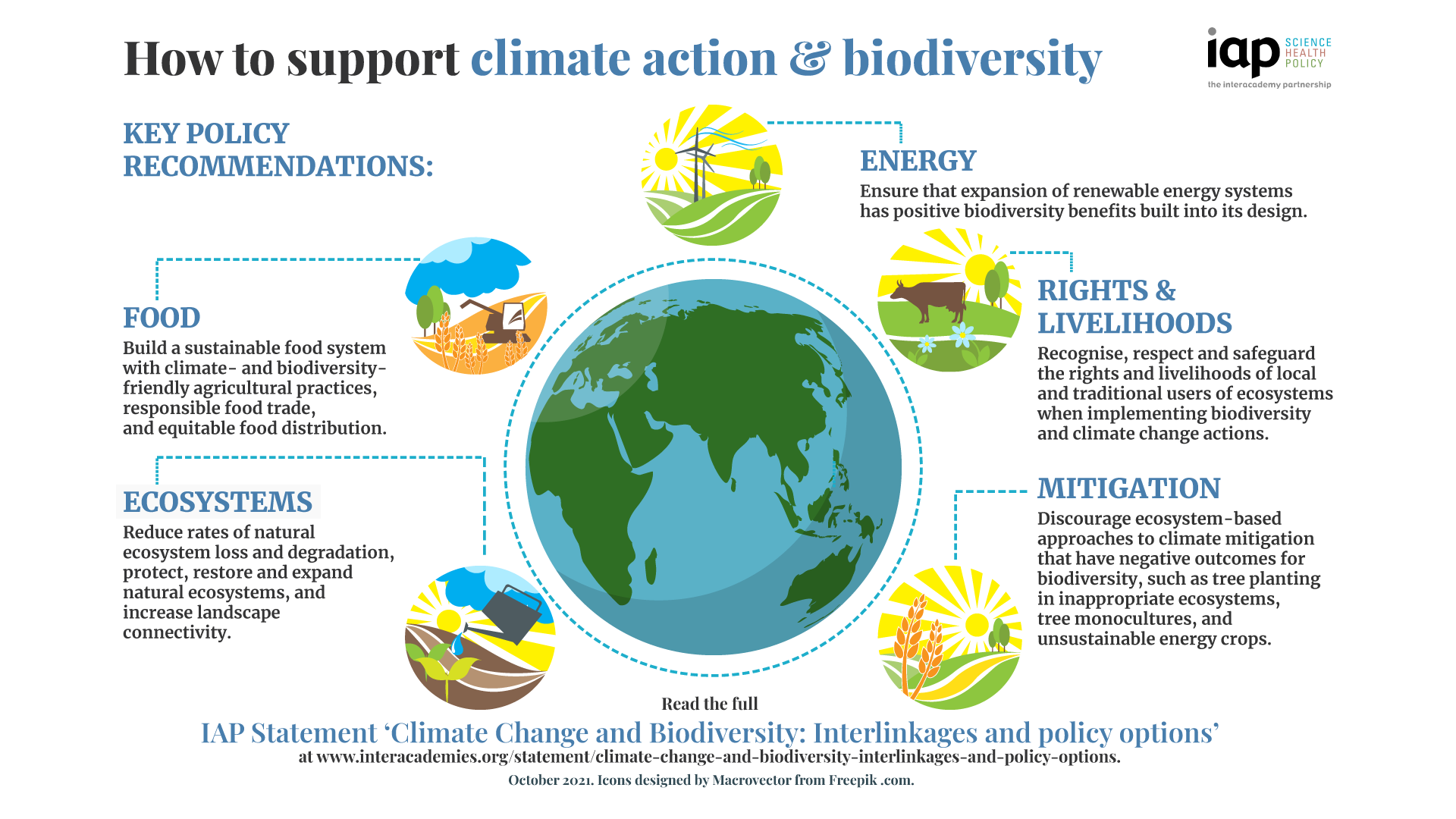Measures that benefit biodiversity have the potential to support climate action and some aspects of climate action can support biodiversity.
The ‘IAP Statement on Climate Change and Biodiversity: Interlinkages and policy options’ includes a section on policy measures that sets out which land-based and sea-based climate policies are beneficial for biodiversity and should therefore be encouraged, and which are not and should therefore be discouraged.
Climate change and biodiversity infographic
The infographic 'How to support climate action and biodiversity' includes the key policy recommendations included in the Statement.
Click on the image below to see the infographic in full size.
Here you can download the infographic on How to support climate action and biodiversity as a PDF or as a high-resolution jpeg.
Tweet this!
🌱Measures that benefit #biodiversity have the potential to support climate action and 🌍some aspects of #ClimateAction can support biodiversity, say world academies.
— InterAcademy Partnership (IAP) 🌍 #science #health (@IAPartnership) October 20, 2021
Read the🆕 IAP Statement https://t.co/cdjBTUvXvs and check our new infographic⤵️ to discover them! pic.twitter.com/dkZqF2b5zp
How to develop a coordinated effort to combat both climate change and biodiversity decline?
Section B of the IAP Statement provides guidance on which climate measures should be encouraged or discouraged based on their impacts on biodiversity.
Policy measures to encourage
Building a sustainable food system
One third of crops are fed to livestock rather than humans, and a third of food globally is lost or wasted. Animal agriculture is a major contributor to global biodiversity loss.
A reduction in meat and dairy consumption and a significant reduction in food loss and waste would not only significantly reduce Greenhouse Gasses (GHG) emissions, which itself benefits biodiversity through limiting climate change, it would also reduce pressure for deforestation with associated biodiversity loss and free land and resources for biodiversity recovery and the wider use of Nature-based Solutions (NbS).
As such, dietary shifts for people who can choose what they eat and reduction in food loss and waste create the enabling conditions that make other actions outlined below more feasible.
A revolutionary change in farming is essential to meeting the goals of the Paris Agreement and reducing biodiversity decline. To achieve that aim, further research on agriculture, which is underfunded compared to other key human activities, should be a priority. Moreover, farmers should be offered financial and other incentives to support climate and biodiversity friendly activities, such as agro-ecological practices.
Sustainable and responsible food trade, and equitable food distribution
Since the price of food and other products does not incorporate environmental externalities, too often, many countries benefit from cheap products that are grown unsustainably in other countries, with the latter having to bear the burden of environmental degradation without benefiting from the food. Avoiding importing food that has been produced unsustainably elsewhere, and instead supporting sustainable production modes and distributing available food fairly amongst those who need it is a critical part of a sustainable and responsible food system.
Reducing rates of natural habitat loss and degradation, particularly of forests.
Deforestation, currently mainly in the tropics and subtropics, is the major contemporary cause of terrestrial biodiversity loss and local climate change, and has contributed 5.7 GtCO2 annual emissions over the last decade, 14% of global CO2 emissions. Reducing deforestation and degradation rates can be achieved through both supporting in situ conservation, resourcing alternative development pathways and reducing international demand for products of deforestation. Reducing deforestation would have the health co-benefit of lowering the risk of disease outbreaks caused by pathogens present in these areas passing from wildlife to humans.
Natural ecosystem restoration and expansion
Expansion of native ecosystems, through restoration and rehabilitation, in a network that facilitates connectivity and species migration, will enhance biodiversity and carbon storage in ecosystems. Natural forests have been calculated to be 40 times better than plantations at storing carbon48. A global forest restoration effort could absorb 2 GtCO2/year. Ecologically appropriate restoration of non-forest ecosystems, such as savannas and grasslands, can increase carbon stocks in soils and maintain biodiversity.
Peatland preservation and restoration
Peatlands have been estimated to store more than 600 Gt or 20% of the global world’s forests49, on only 3% of its land. Peatland preservation and restoration has multiple benefits for amenity, water resources, flood protection, biodiversity and the climate. For example, restored peatlands show renewed growth of Sphagnum moss species and attract invertebrates and birds. Existing drained peatlands globally are expected to cumulatively release the equivalent of nearly 2 GtCO2 that could be saved by restoration.
Extension and enforcement of Marine Protected Areas (MPAs)
As well as restoring and protecting biodiversity, and helping it to be resilient to climate change, many MPAs support climate resilience, either by protecting the coastline from severe weather events, for example through coral reefs or mangroves, or by absorbing carbon dioxide in seagrasses, salt water reedbeds and muddy habitats. To be effective, MPAs should be extended with new investment in their management and enforcement of protection rules.
Biodiversity friendly renewables
Upscaling of renewable energy production should avoid negative impacts on biodiversity where possible. For example, engineers can design offshore wind farms to be biodiversity friendly and attract species under water. Techniques include structures on which new reefs can grow along with fish habitats and sea grass settlements.
Overall, marine sites where renewable energy technologies are being deployed should be managed to optimise potentially positive effects, by adopting exclusion zones from other destructive activities such as bottom trawling and dredging and support the colocation of other industries such as mariculture that support wider benefits from nature. On land, solar farms should avoid fragmenting habitats or becoming barriers to the movement of animals56. It is also important to source raw materials for renewables in a way that ensures minimal damage to biodiversity.
Increased landscape connectivity
Creating corridors (for example restoring river corridors planting and connecting conservation efforts) and increased coverage of semi-natural ecosystems in intensively used landscapes will assist species migration and support ecosystem resilience in a changing climate. Increasing green spaces in cities is vital for adaptation as they have a cooling effect and support biodiversity and its connectivity. They contribute to climate change mitigation through carbon storage, and enable many biodiversity-associated mental and cultural welfare benefits to urban people.
Policy measures to discourage
Tree planting in inappropriate ecosystems.
Expanding tree cover in ecosystems that do not naturally support expansive tree cover (e.g. grasslands, grassland savannas, temperate peatlands) has negative consequences for biodiversity and ecosystem functioning. In the case of peatlands, planting trees can also have negative climate consequences by resulting in drainage and consequent release of soil carbon reserves.
Monocultures
Planting trees, either for bioenergy or as long-term carbon sinks, should focus on restoring and expanding native woodlands, as well as avoid creating large monoculture plantations that do not support high levels of biodiversity. Simple targets such as ‘numbers of trees planted’ ignore biodiversity considerations, such as long-term survival of trees or stewardship, and can be misleading, potentially contributing to policy failure and misuse of carbon offsets.
Unsustainable energy crops
The modelled benefits of Bioenergy with Carbon Capture and Storage (for example, the use of crops to generate power and fuel while capturing CO2) to mitigate climate change are significant.
However, the scale of some modelled deployments would either take up large amounts of land now used for food production or have negative effects on the amount of land available for preservation or restoration of natural ecosystems. Policy should also limit use of fuelwood pellets and other feedstocks for bioenergy where it might intensify pressure on semi-natural ecosystems.
Disempowerment of indigenous and local communities
Biodiversity and climate change actions should recognise, respect and safeguard the rights and livelihoods of local and traditional users of ecosystems.


